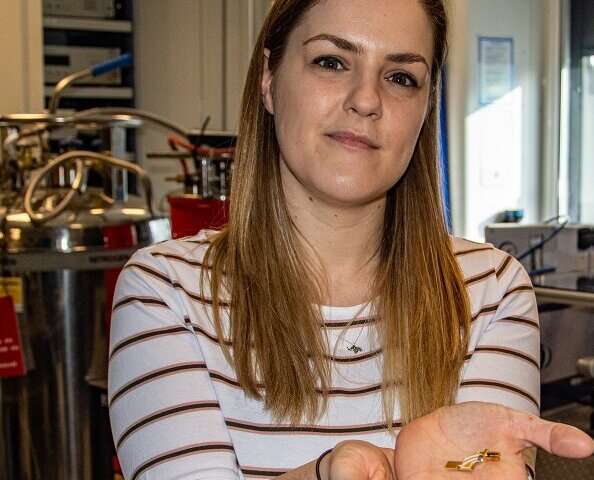 |
The terahertz quantum cascade laser on its mounting. A pair of tweezers shows how small the device is. Credit:
|
Researchers have made a breakthrough in the control of terahertz quantum cascade lasers, which could lead to the transmission of data at the rate of 100 gigabits per second—around one thousand times quicker than a fast Ethernet operating at 100 megabits a second.
What distinguishes terahertz quantum cascade lasers from other lasers is the fact that they emit light in the terahertz range of the electromagnetic spectrum. They have applications in the field of spectroscopy where they are used in chemical analysis.
The lasers could also eventually provide ultra-fast, short-hop wireless links where large datasets have to be transferred across hospital campuses or between research facilities on universities—or in satellite communications.
To be able to send data at these increased speeds, the lasers need to be modulated very rapidly: switching on and off or pulsing around 100 billion times every second.
Engineers and scientists have so far failed to develop a way of achieving this.
A research team from the University of Leeds and University of Nottingham believe they have found a way of delivering ultra- fast modulation, by combining the power of acoustic and light waves. They have published their findings today in Nature Communications.
John Cunningham, Professor of Nanoelectronics at Leeds, said: "This is exciting research. At the moment, the system for modulating a quantum cascade laser is electrically driven—but that system has limitations.

"Ironically, the same electronics that delivers the modulation usually puts a brake on the speed of the modulation. The mechanism we are developing relies instead on acoustic waves."
A quantum cascade laser is very efficient. As an electron passes through the optical component of the laser, it goes through a series of 'quantum wells' where the energy level of the electron drops and a photon or pulse of light energy is emitted.
One electron is capable of emitting multiple photons. It is this process that is controlled during the modulation.
Instead of using external electronics, the teams of researchers at Leeds and Nottingham Universities used acoustic waves to vibrate the quantum wells inside the quantum cascade laser.
The acoustic waves were generated by the impact of a pulse from another laser onto an aluminium film. This caused the film to expand and contract, sending a mechanical wave through the quantum cascade laser.
Tony Kent, Professor of Physics at Nottingham said "Essentially, what we did was use the acoustic wave to shake the intricate electronic states inside the quantum cascade laser. We could then see that its terahertz light output was being altered by the acoustic wave."
Professor Cunningham added: "We did not reach a situation where we could stop and start the flow completely, but we were able to control the light output by a few percent, which is a great start.
"We believe that with further refinement, we will be able to develop a new mechanism for complete control of the photon emissions from the laser, and perhaps even integrate structures generating sound with the terahertz laser, so that no external sound source is needed."
